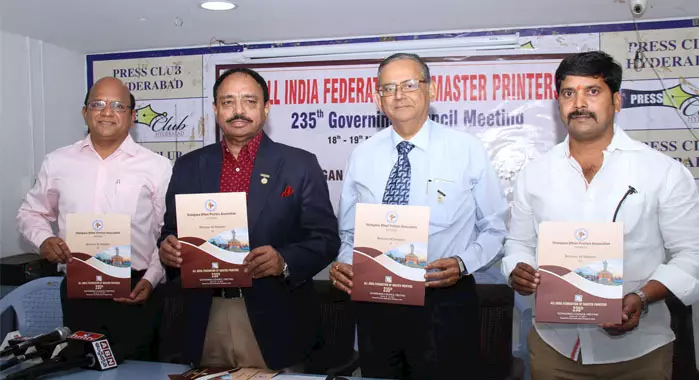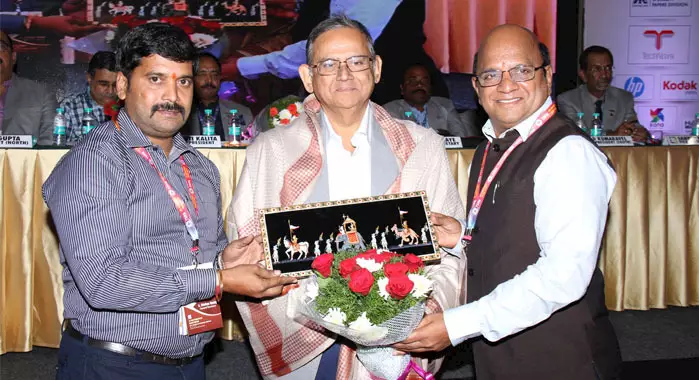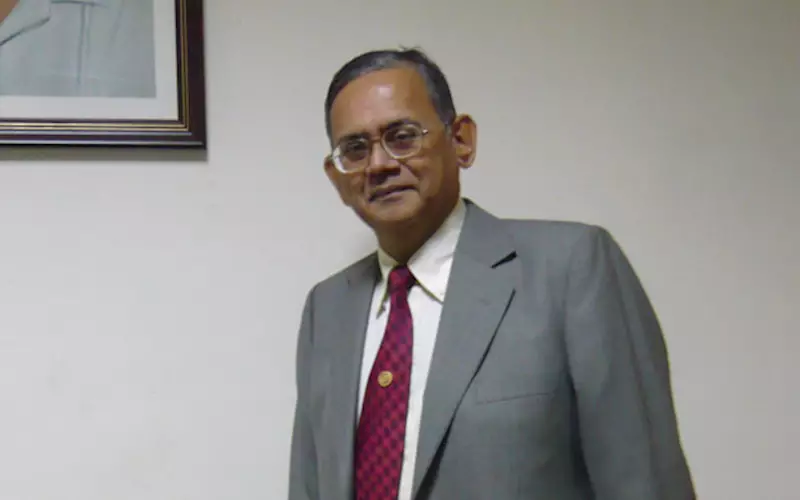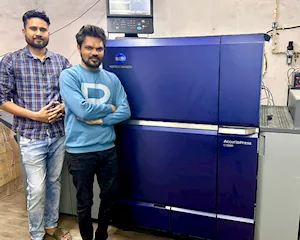Anand Limaye: The man on a mission
Anand Limaye, the honorary general secretary of AIFMP and head at India Printing Works is trying to draw a new map for the Indian print industry. Last week, he lodged a plaint against paper cartelisation. Also he is attempting to take the message of print to the society, and with his latest passion, Inking Innovations, sharing the wealth of Marathi literature to a larger audience. Anand Limaye in conversation with Ramu Ramanathan.
03 May 2017 | By Ramu Ramanathan
You are in the news for having taken on the might of the paper mills.
Yes. I have slapped a complaint before the Joint Director General, Unit-V of DGCCI office i.e. Competition Commission of India (CCI) in New Delhi.
Why so?
This is about the paper cartelisation and the subsequent price hike. Once convinced about the cartelisation, the CCI will start the investigations. If they find truth in the complaint, CCI will stay the price increase. Plus it can penalise them.
I see. And the roots to this complaint are embedded in the paper price hike?
Yes. In the last 15 months, all these paper mills have increased their prices by 22.6% without any substantial reason. Except for the recent increase in pulp prices, there was no other rise in other input costs, viz labour, bank interests, electricity, water charges or any administrative costs. It’s observed that all mills have increased prices, simultaneously. This compels you to consider that they are working hand-in gloves.
Lots of developments in the past 12 months at the AIFMP with you, Kamal Chopra and Arvind Mardikar at the helm. What kind of success have you accrued?
There are three main things. One, transparency in all transactions so there are no decorative posts on the AIFMP dais. Then there is better communication with fellow members. Also, we have set right the AIFMP office secretariat. Now the office is working all six days of the week.
What are the other things?
The AIFMP as you know was formed to create an awareness among the society at large about printing as a trade. We have started publish Printing Times on schedule with quality content as well as presentation. Also we have spread the name of AIFMP throughout the world as well as supported Indian students to learn about the state-of-the-art machinery and latest technology. Plus make representations to government about the grievances of the print industry. And finally, to ensure the NAEP operates at an international standard. The plan is to host the award distribution ceremony to coincide with Pamex along with a display gallery. Our endeavour is to surpass all other award shows in the country.
The Romancing Print outreach programme in 2017 was interesting – and gruelling - project. Share the highlights, please?
The feedback is encouraging thus far. The Federation had not reached out to these two-tier cities. Thus we reached out to a maximum number of printers from mofussil areas. This was a first in the history of AIFMP. An event organised for the dissemination of knowledge.

Second from right: Limaye at 235th Governing Council Meeting
Such as?
We had talks by experts on taxation, labour laws, safety and precautionary measures, insurance, recovery, personality development and so on. All our vice presidents worked tirelessly and conducted the first round of Romancing Print as follows: Rajendra Jain, vice president (west) hosted Romancing Print in Bhopal on 11 February for 150 printers from four cities. Arun Kumar Gupta, vice president (north) hosted Romancing Print in Pathankot in Punjab on 26 February for 150 printers from 12 cities. C D Kumaravel, vice president (south) hosted Romancing Print in Trichy in Tamil Nadu on 5 March for 250 printers from 20 cities and finally, Sandeep Kumar Sanyal, vice president (east) hosted Romancing Print in Durgapur, near Kolkata on 25 March for 200 printers from 10 cities.
Extraordinary, that’s almost a thousand printers in a month.
Correct. Also, we met more than 36 different associations of printers. These include those who are not affiliated with AIFMP as well as more than 750 printers not connected with AIFMP. Over and above, we hosted press conferences in all these cities, whereby we could create awareness about printing industry among the society/the citizens of the country.
It’s so competitive in commercial printing, some people think there’s going to be a big shake-up. You have been travelling across India, what is your sense of the commercial print market?
No doubt commercial printing is passing through the bad patch. But there are various angles to it.
What type of angles?
The buyers have reduced their budget on printing and shifted to eMarketing. Just to present the ground reality. The printer who works on a conventional offset printing machine used to print 10 to 12 jobs per shift. This printer had 20 jobs in hand. Instead of offloading the excess jobs, he preferred to invest in a fully loaded auto plate with CIP 4 etc. These machines have a capacity to print at least 35 to 40 jobs per shift as against 20 jobs on hand. So for additional jobs, one has to scour the market for optimum utilisation of the machine as the printer cannot afford to keep the machine idle due to the financial burden of a high interest. In such a scenario, who is his competitor, not the market, nor the neighbouring printer, but himself. The print CEO has created competition for his own unit.
Your view on digital print?
Yes, the short runs have shifted to digital which proves to be cheaper and faster.
Is that why IPW invested in a Konica Minolta recently?
We are engaged in book printing and it’s observed that when we print 500 copies of 240 to 500 pages of text, we just print one cover. Similarly for some of the magazines, after printing the text in single colour, the cover and ads are being printed on a four-colour machine. We have observed that for A5 size book covers, up to the print run of 1,000, digital print proves to be cheaper, whereas, in single-colour, the digital proves to economical and viable up to a print run of 200.
Returning to AIFMP, your goal is to make the not-for-profit AIFMP the best-known print trade body in the industry. Right?
No doubt, to run the association and to support and execute our plans for education, we need funds. As everyone is aware that the excessive money pouring in the family can only spoil the children/next generation. Therefore, this year we have decided to execute our plans without touching the existing funds of the AIFMP. In this endeavour, some like-minded companies like TechNova and Konica Minolta have supported us.
So? Where has AIFMP faltered as compared to the other industry bodies?
We may not be as successful as other trade bodies. ‘Ho sakta hein, humara pyaar unse thoda kum hai’ (Perhaps our love is less). Having said that, we will overcome that problem shortly by consistent representations which are drafted with a thoroughly-researched background.
You have not answered my question?
What is your question?
In spite of such a huge pan India network; why is AIFMP not exactly the best-known trade body in India? Others do so much more and are visible across industry platforms.
My personal opinion is that AIFMP is the national level apex body and affiliates are city level associations. Naturally, the member is bound to give first preference to his mother association. His first attempt would be to collect more articles or advertisements for the magazine published by his mother association instead of the Printing Times published by the Federation. The associations from Maharashtra will certainly try to retain the printing work of textbook in Maharashtra as is the case of Gujarat, but the AIFMP cannot take such a stand being a federal body.

(c) Limaye being honoured at an event
I see. Speaking of textbooks, you have been active in Maharashtra with the Government textbook project. The situation is grim due to the lack of supply of paper in the market. Your view?
The Maharashtra State Textbook Bureau is the single largest buyer of paper in India. But the scarcity is not due to their purchase. Two large paper manufacturing units of Ballarpur and TNPL are closed down. As I see it, the other functioning mills are taking undue advantage of this situation.
Staying with Maharashtra. These are interesting times in Marathi publishing. Is that why you launched Inking Innovations?
No doubt about it. But just one clarification, Inking Innovations is formed not only for Marathi books but to translate the best in Marathi literature, the real gems in Marathi into English. The plan is to take these words beyond the boundaries of Maharashtra or rather to establish an international market. Inking Innovations publishes books, which has documentation value or a message for society, and even medical science guides for the common man.
What is happening with the big five Marathi publishers like Popular, Mouj, Rajhans, Granthali, Majestic? Very little is known about their clout outside Maharashtra.
Their work is confined to Maharashtra or at times in US/UK for the older generations who have migrated to these countries. The major problem is not of sale.
Then?
The two problems they have to overcome is to reach to the reader as the newspaper advertisements in Marathi mainstream dailies has become prohibitive due to cost; and the recovery. A majority of the booksellers, retailers don’t pay for years even though they get cash through the counter sale.
What is the solution?
The Maharashtra government has to take a pro-active interest and to establish book villages all around the state at a minimum cost with the aim to develop a reading habit for Marathi literature. Only last week, Bhilar is all set to embrace the tag of India's first 'village of books', a concept inspired by Britain’s Hay-on-Wye, a Welsh town known for its bookstores and literature festivals. This project is undertaken by the Marathi Bhasha department wherein 25 locations around the village will turn into reader hot spots with a display of books. This is a good start. We need many more book villages in Maharashtra.
I agree. Just now, publisher Arun Shewate was seated with us at IPW. He is an interesting publisher with a best-selling title like Ruturang Prakashan – Napas Mulanchi Goshta, which has been reprinted more than 40 times. Other than him, you have also printed titles by Acharya Atre to Dr Narendra Jadhav. Give me a sense of the work IPW has done?
Oh. There are many. Nothing to beat Acharya Atre whose biography in six volumes containing 1,800 pages is in demand and the publisher sells almost thousand sets a year after 40 years of Acharya Atre’s death. Same is the case with PL Deshpande, popularly known as PuLa. His books are being reprinted every year – minimum eight titles of 2000 copies each. Same is the case with Jnanpith Award winners like Vinda Karandikar and Bhalchandra Nemade. Popular Prakashan’s The Hindu notched up 10,000 copies a year and Kosla approximately 2,000 copies. And then as you mentioned, you can look at Uchlya of Arun Shewate’s Ruturang Prakashan – Napas Mulanchi Goshta, which has been reprinted more than 40 times or Dr Narendra Jadhav’s – Amhi Ani Macha Baap has had 172 editions. The same has been translated into 18 languages – Indian as well as foreign. More than one lakh copies of Sane Guruji’s Shyamchi Aai were printed and sold by the late Prakashbhai Mohadikar. As the copyright period is over, now many publishers are publishing his books. Similarly, small booklets on Babasaheb Ambedkar, are being printed in thousands to commemorate his death anniversary on 6 December every year. And so on.
And what are the numbers for the "literary and art and culture" Little Magazines in Marathi?
Difficult to collect statistics, as many publishers step in the line. But they vanish in a very short period due to lack of sustaining power or poor recovery. The new trend in Marathi is to publish books at the cost of authors. This is killing the market as such publishers are least concerned about the recovery from booksellers.
Bikkat paristheethi! Grim situation!
The only solution for the survival of printers and publishers is to have a lot more faith in each other and work in a consortium. At IPW, we outsource our jobs to many printers. I have found that these printer friends have never approached our clients directly. Likewise, we execute their jobs. If you remember during the 80th-anniversary celebration of IPW, though we were not in the business of publishing, we had convened a meeting of publishers to discuss their problems and find a solution. The meeting concluded with only one solution – join hands with the fellow publisher. Sadly, very few publishers are doing so.
Thankfully, it’s a bit better among the print associations. At least in Mumbai, the BMPA and MMS have joined hands.
Yes.
The official status on Pamex in these tough times? The question we hear from suppliers and traders is, is it necessary to host a show in the same year as PrintPack?
There is a gap of one year.
So you are confident of a good show?
Pamex is being hosted in Mumbai, the centrally located venue, convenient to exhibitors as well as visitors. Being the financial capital of India, a majority of visitors find it convenient to visit Pamex as well as to organise other business meetings and client appointments. This year onwards, we will be hosting NAEP to coincide with Pamex. Since 2006, it is a developing brand and gaining popularity. This year the China Pavilion will be of 1,000 sq/mtrs.
AIFMP has been expending a lot of energy in the China territory. Would it not be better to develop Indian manufacturers for spares of print, packaging and bindery machines?
Certainly. The task is to be shouldered by the Indian print manufacturers body, that is, IPAMA. AIFMP has always extended its full support to Indian manufacturers. We take Indian printers to China to observe how Chinese print factories can produce good/acceptable quality products at cheaper rates. If individually it’s not possible in India, let them try to do so through a consortium. The main thing is: to manufacture printed goods at a price that China should never be in a position to export to India.
The AIFMP has spoken about this for the past two decades: Creating partnerships with organisations within and beyond the print industry. Any progress on that front?
Yes, this year is declared as networking year and will host a joint meeting of all such federations – paper manufacturers, ink manufacturers, machinery manufacturers, traders and allied industries also. The AIFMP has kept aside a corpus to host this meeting.
Anand Limaye, what is your big plan? I mean what’s your dream for the AIFMP before you exit? Three things on your list.
The print data bank project. We are developing the data bank to prove our number and strength. Also, I am keen to create awareness among the society about the print industry as a trade for children to take up as a career. And finally, the government as well the printers associations all over the world should declare 24 February as Printers’ Day, in memory of Johannes Guttenberg. This builds the self-confidence and pride among printers.
Thank you.
Now for some chai and wada pav?
The AIFMP roots
Parmanand Sugomal Mehra, who worked at Bolton Fine Arts Litho Works, Bombay took the initiative of uniting independent associations of printers formed after World War - II. The printers of Madras were the first to respond to his call and the MPLA came into existence in July 1952. A need was felt to create an All India Association and some leading printers from Tamil Nadu, Maharashtra, Delhi and Bombay joined hands to form the All India Federation of Master Printers (AIFMP).
The AIFMP founders
The Federation was registered in Madras in 1953 under the Registration of Societies Act 1860. The following were the first Office Bearers:
President: J C Jain, Times of India Group
Hon. Secretary: S Viswanathan
Hon. Treasurer: V M Philips
The following were the founders :
V M Philips, Diocesan Press, Chennai
R Venkateswaran, United Printers Syndicate, Chennai
S Viswanathan, Viswanathan Printers and Publishers, Chennai
J C Jain, Delhi
S N Guha Roy, Saraswati Printing Works, Kolkata
S Ramu, Tata Press, Mumbai
N K Gossain, Kolkata
G U Mehta, Mumbai
H K Das, Kolkata
Ghosh, Kolkata
The Association was re-registered in Delhi on 22 February 2006.
How to become an AIFMP member
Any association of printers having a minimum number of 20 member units registered under the Registration of Societies Act, Indian Companies Act etc – is eligible to apply as an affiliate member of the Federation.
Affiliate members can nominate their representatives as GC/GB members of the Federation in accordance with the total membership of their association.
The total Affiliate membership is 74 Print Associations, thus far. Periodically applications for becoming members of the AIFMP are received. All such applications are considered by the Governing Council of the Federation which meets every quarter and decision is taken to admit or reject an applicant.














 See All
See All